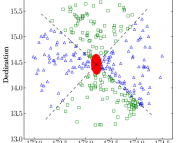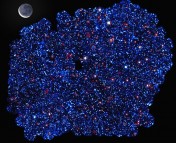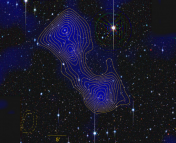Title: Sloan Great Wall as a complex of superclusters with collapsing cores
Authors: M. Einasto, H. Lietzen, M. Gramann, E. Tempel, E. Saar, L. J. Liivamägi, P. Heinämäki, P. Nurmi, J. Einasto
First Author’s Institution: Tartu Observatory, Tõravere, Estonia
Status: Accepted for publication in Astronomy and Astrophysics
The sheer scale of the universe is overwhelming. Much of the universe is filled with a complex web of matter—what cosmologists like to call the “structure” of the universe. Most everything we know and love—the wispy cloud in the sky, the bright nebulas that pierce the natal darkness of giant molecular clouds, the faint and distant galaxies—are gravitationally bound to something. One can continually zoom out to larger and larger scales, and you’ll see that objects that looked lonely on one scale are often surrounded with similar objects: our Sun is but one of the 200 billion stars the Milky Way Galaxy, which in turn is but one of about 50 galaxies in the Local Group, which in turn is one of 300-500 galaxy groups and clusters in the Laniakea Supercluster. But this is where the cosmic, fractal structure of hierarchically gravitationally bound objects ends. The largest structures we see in the universe—superclusters—enter into territory where gravity no longer reins, and all collections of matter at larger scales are subject to the expansion of the universe.
These vast and massive superclusters are the objects of study of the authors of today’s paper. Clues to uncover the universe’s remaining secrets—such as the cosmological model and the processes that formed the present-day web—are encoded in the structures of superclusters. Superclusters are also the birthplaces of clusters, and the resultant structures therein. Thus the authors seek to study in detail such properties of superclusters. They turn to the closest collection of superclusters bursting with galaxies discovered in the Sloan Digital Sky Survey (SDSS), the eponym for the Sloan Great Wall (SGW) of galaxies, which contain galaxies spanning a redshift z of 0.04 to 0.12.

Figure 1. Galaxy groups (circles) in the Sloan Great Wall. The groups have been color coded by the supercluster they were identified to be in. The size of the circles denotes the spatial extent of the group as we would see them in the sky. Note the elongated morphologies of the superclusters. Figure taken from today’s paper.
The authors uncovered a rich hierarchy of structure in the Great Wall. They find five superclusters with a luminosity density cutoff, all massive—accounting for invisible gas and galaxies too faint to detect, they estimate that these superclusters range in mass from about 1015 M☉ to a few 1016 M☉—one to ten thousand times the mass of the Milky Way. Two of the superclusters are visibly “rich” and contain 2000-3000 galaxies each (superclusters 1 and 2 in Figure 1), while three are “poor,” containing just a few hundred visible galaxies.
Using a novel method to identify how the galaxies cluster, they find that each supercluster in turn contains highly dense “cores” of galaxies. The rich superclusters contain several cores with tens to hundreds of galaxy groups and range from 1014 M☉ to a few 1015 M☉. These cores in turn contain galaxy clusters, comprising a single galaxy cluster or containing multiple clusters. Within these cores are what astronomers would consider the first “true” structures—extremely dense regions which no longer grow with the expansion of the universe but instead collapse into bound objects. The authors derive density profiles for the cores in the rich superclusters and find that the inner 8 h-1 Mpc (about 2000 times larger than the Milky Way; h-1 denotes the normalized Hubble constant) of each core is or will soon be collapsing.
The superclusters are lush with mysterious order beyond their spatial hierarchy. One of the rich superclusters (#1 in Figure 1) appears to have a filamentary shape and which contains many red, old galaxies. The other rich supercluster (#2) is more spidery, a conglomeration of chains and clusters of galaxies, all connected, and contains more blue, young galaxies. These differences in shape and color could indicate that the superclusters have different dynamical histories. The largest objects of our universe remain to be further explored!





Great writing. I particularly like the sentence: The superclusters are lush with mysterious order beyond their spatial hierarchy.
Congratulations on making your subject not only comprehensible to a lay audience but also a pleasure to read.
James Semple Devon England
Very nice! It would be cool to correlate these superclusters with the 2MRS data set, which makes a lovely 3D visualization but is hard to correlate with many large-scale structures due to local motions screwing up the redshift-distance relation.